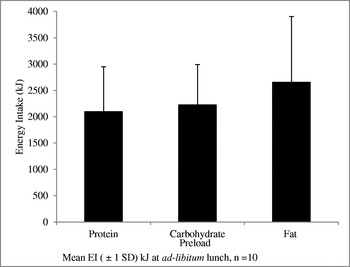It has been proposed that there is a macronutrient satiety hierarchy( Reference Blundell and MacDiarmid 1 ) with protein being more satiating than carbohydrate which in turn is more satiating than fat. There is also a broad consensus that the energy density (ED) of foods affects energy intake (EI) and satiety( Reference Drewnowski, Almiron-Roig and Lluch 2 ). Manipulating the satiating effects of foods may influence EI in humans which in turn may help in the control of the dramatic increase in obesity( 3 ). Few studies have manipulated all 3 macronutrients whilst maintaining ED. The objective of the present study was to examine the relative satiating power of these macronutrients when ED was held constant.
On three separate occasions, the effect of a manipulated preload drink on satiety and EI was tested in 10 women. Each preload contained 1.4 MJ of energy with an ED of 6.4 kJ/g and was enriched with 50 g of whey protein isolate, 48 g of maltodextrin or 16 g of corn oil. The volumes and taste of the preload were closely matched. 60 minutes post-consumption of the preload, participants ate freely from an ad-libitum lunch and EI was measured. Participants completed 100 mm visual analogue scales (VAS) rating hunger, fullness and desire to eat immediately pre and post the preload and pre and post the lunch. VAS ratings of taste and texture were completed following preload consumption.

Difference in EI narrowly failed to achieve significance (p=0.052). The preloads did have a significant effect on hunger (p<0.05) with participants rating themselves less hungry after the protein preload. However, there was no significant effect on fullness or desire to eat. In conclusion, only protein consumed at a dose of 765 kJ in a volume of 235 ml at an ED of 6.4 kJ/g may exert a weak effect on hunger but not on EI. At such dosages and volumes the macronutrient satiety hierarchy was not demonstrated.




